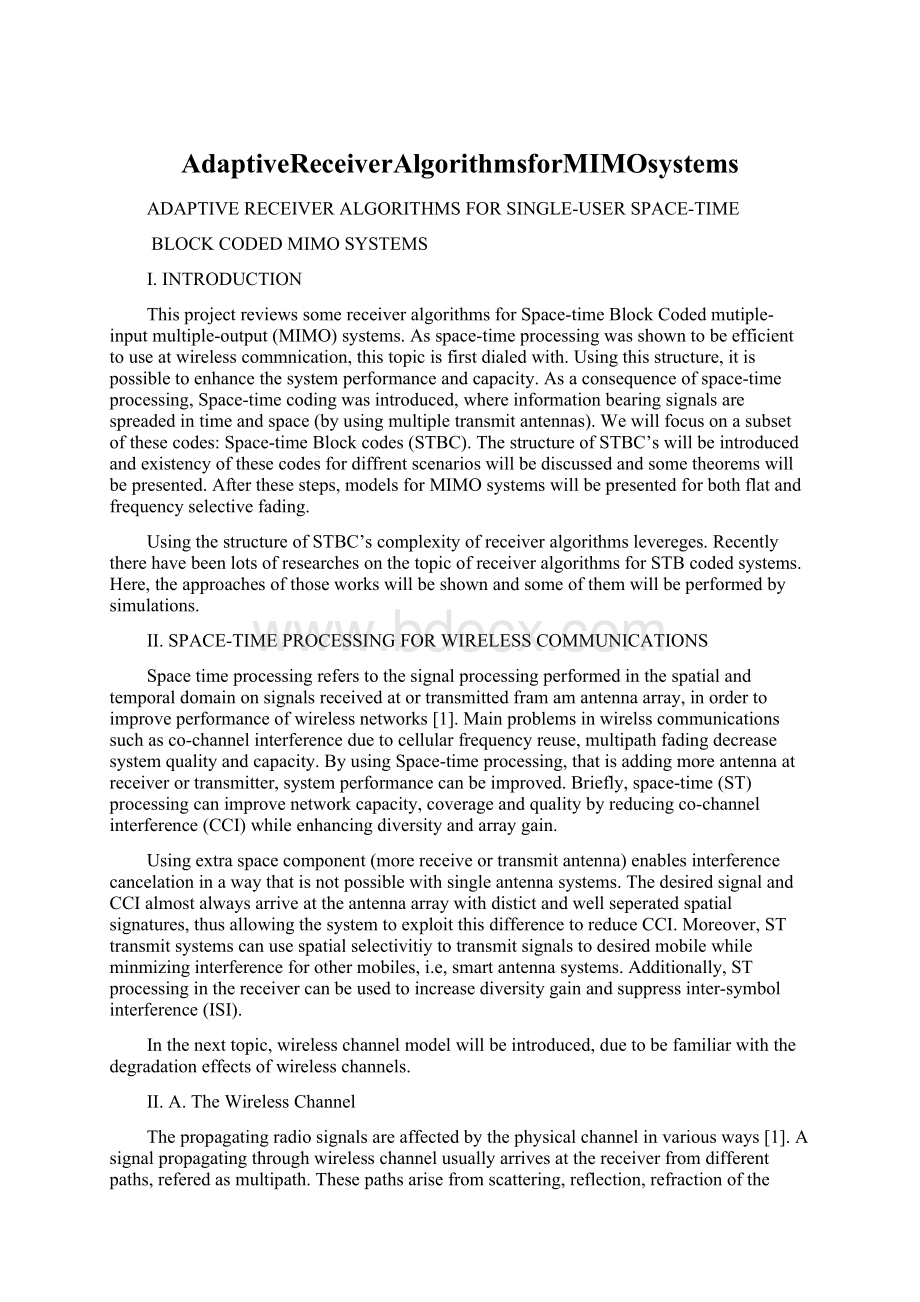AdaptiveReceiverAlgorithmsforMIMOsystems.docx
《AdaptiveReceiverAlgorithmsforMIMOsystems.docx》由会员分享,可在线阅读,更多相关《AdaptiveReceiverAlgorithmsforMIMOsystems.docx(18页珍藏版)》请在冰豆网上搜索。

AdaptiveReceiverAlgorithmsforMIMOsystems
ADAPTIVERECEIVERALGORITHMSFORSINGLE-USERSPACE-TIME
BLOCKCODEDMIMOSYSTEMS
I.INTRODUCTION
ThisprojectreviewssomereceiveralgorithmsforSpace-timeBlockCodedmutiple-inputmultiple-output(MIMO)systems.Asspace-timeprocessingwasshowntobeefficienttouseatwirelesscommnication,thistopicisfirstdialedwith.Usingthisstructure,itispossibletoenhancethesystemperformanceandcapacity.Asaconsequenceofspace-timeprocessing,Space-timecodingwasintroduced,whereinformationbearingsignalsarespreadedintimeandspace(byusingmultipletransmitantennas).Wewillfocusonasubsetofthesecodes:
Space-timeBlockcodes(STBC).ThestructureofSTBC’swillbeintroducedandexistencyofthesecodesfordiffrentscenarioswillbediscussedandsometheoremswillbepresented.Afterthesesteps,modelsforMIMOsystemswillbepresentedforbothflatandfrequencyselectivefading.
UsingthestructureofSTBC’scomplexityofreceiveralgorithmslevereges.RecentlytherehavebeenlotsofresearchesonthetopicofreceiveralgorithmsforSTBcodedsystems.Here,theapproachesofthoseworkswillbeshownandsomeofthemwillbeperformedbysimulations.
II.SPACE-TIMEPROCESSINGFORWIRELESSCOMMUNICATIONS
Spacetimeprocessingreferstothesignalprocessingperformedinthespatialandtemporaldomainonsignalsreceivedatortransmittedframamantennaarray,inordertoimproveperformanceofwirelessnetworks[1].Mainproblemsinwirelsscommunicationssuchasco-channelinterferenceduetocellularfrequencyreuse,multipathfadingdecreasesystemqualityandcapacity.ByusingSpace-timeprocessing,thatisaddingmoreantennaatreceiverortransmitter,systemperformancecanbeimproved.Briefly,space-time(ST)processingcanimprovenetworkcapacity,coverageandqualitybyreducingco-channelinterference(CCI)whileenhancingdiversityandarraygain.
Usingextraspacecomponent(morereceiveortransmitantenna)enablesinterferencecancelationinawaythatisnotpossiblewithsingleantennasystems.ThedesiredsignalandCCIalmostalwaysarriveattheantennaarraywithdistictandwellseperatedspatialsignatures,thusallowingthesystemtoexploitthisdifferencetoreduceCCI.Moreover,STtransmitsystemscanusespatialselectivitiytotransmitsignalstodesiredmobilewhileminmizinginterferenceforothermobiles,i.e,smartantennasystems.Additionally,STprocessinginthereceivercanbeusedtoincreasediversitygainandsuppressinter-symbolinterference(ISI).
Inthenexttopic,wirelesschannelmodelwillbeintroduced,duetobefamiliarwiththedegradationeffectsofwirelesschannels.
II.A.TheWirelessChannel
Thepropagatingradiosignalsareaffectedbythephysicalchannelinvariousways[1].Asignalpropagatingthroughwirelesschannelusuallyarrivesatthereceiverfromdifferentpaths,referedasmultipath.Thesepathsarisefromscattering,reflection,refractionofthesignalsfromsurroundedobjects.Thereceivedsignalismuchweakerthanthetransmittedoneduetotheeffectofpath-loss,slowfading(long-termfading)andfastfading(short-termfading).Multipathpropagationresultsinthespreadingofthesignalindiffrentdimentions.Thesearedelay(time)spread,Doppler(orfrequency)spreadandanglespread.Infreespacepropagationpath-losscaneasilyfound.Fadingcanbecalculatedasmultiplicationofbothshortandlongtermfadingcomponents.Slowfadingcanbecharacterizedbyadistributionwhichisaffectedbyantennaheights,operatingfrequenciesandtypeofenvironment.OneofthemostprominentstatisticalmodelisOkamuramodel.FastfadingcomponenthasRayleighdensityfunctionifthereisnodirectpathfromsignalingparts.Rayleighdistributionisasfollows,
(1)
Ifthereisadirectpath,fastfadingcomponentwillhaveRiciandensityfunction,whichisasfollows,
A≥0ver≥0
(2)
Effectsofmultipathinsmallscalefadingisdetailedin[2].
II.B.ReceivedSignalModel
IngeneralchannelmodelforMIMOsystemincludephysicalparametersuchaspathgain,delayandangleofarrival.Butinmostcaseitisconvenienttousesampledmodelofreceivedsignal.Ifwethinkthatreceivedsignalx(t)issampledatt=t0+kT,thentheoutputmaybewrittenas
x(k)=Hs(k)+n(k)(3)
whereHisthechannelresponse(mxN)matrixthatcapturesallofthemultipatheffects.MisnumberofantennasandNisthechannellength.Hisassumedbetime-invarianthere,sofadingisconstant.s(k)containingthetransmittedsymbolsisdefinedas
s(k)=
(4)
Itisoftenconvenienttohandlesignalsinblocks.ThereforewemaycollectMconsecutivesnaoshotsofx(.)correspondingtimeinsatantsk,....,k+M–1andneglectinginterference,weget
x(k)=HS(k)+N(k)(5)
Usingmodel(5)somecommonSTalgorithmswillbeshowninnexttopicduetogivesomeinferenceonwhatisgoingtobeusedforreceiveralgorithmsonthenextsections.
II.C.STAlgorithms
Heresingleusercasewillbedialedandinterferencefromotheruserswillbetreatedasadditivenoise.
II.C.1.MLandMMSE
OnecriterionforoptimalityusedinSTprocessingisMaximumLikelihood(ML).Maximumlikelihoodsequenceestimation(MLSE)seekstoestimatethedatasequencewhichismostlikelytohavebeensentgeventhereceivedsignalvector.AnotherfrequentlyusedcriterionisMinimumMeanSquareError(MMSE).InMMSEweobtainanestimateofthetransmittedsignalasaspace-timeweightedsumofthereceivedsignalandseektominimizethemeansquareerrorbetweentheestimateandthetruesignal.
MLSE:
Usingthemodelin(5),wewillassumethatNisspatiallyandtemporallywhiteandGaussian,andthereisnointerference.TheMLSEproblemisreducedtofindSsoastosatisfythefollowingcriterion
(6)
wherethechannelHisassumedtobeknown.ThisisgeneralizationofthestandardMLSEproblemiasnowthechannelisdefinedinspaceandintime.
MMSE:
Inapplicationswhereinterferenceispresent,wewillnothaveknowledgeoftheinterferencestatistics.WecannolongeruseMLSEandonealternativeapproachisMMSE.InMMSE,weseektofindaspace-timefilterthatlinearlycombinesthearrayoutputsuchthatthedifferencebetweenitsscalaroutputandthetruesignalisminimized.TheMMSEcriterionis
(7)
whereDisadelaychosentocentertheSTfilter.ThesolutiontothisLeastSquare(LS)problemfollowsfromthewellknownprojectiontheorem.Definingthespace-timemNxmN
covariancematrix
andWisgivenby
(8)
Therearemanytrade-offsbetweenthisapproach,LMS,andRLSthatspansnumericalstability,convergencespeedandcomputationalcomplexity.
II.C.2.BlindandNon-Blind(TrainingBased)Methods
Intheabovemethods,weassumethatthechanelisknownatreceiver.Inpractice,Hmaynotbeknown,butanestimatebyusingtrainingsignalscanbeused.Analternativeapproachconsistsof“blind”methodsthatdonotusetrainingsymbols,andinsteadusethepropertiesofthereceiversignaltodetermineHandS.Here,someoftheseproperties(structures)aredescribed.
II.C.2.a.SpatialStructure
ArrayManifold:
Asitissaidthatchannelmatrixincludesmultipatheffects,whichcontainsdirectionofsignalarrivals.Knowingarraymanifold,A,helpsdeterminethearrayresponsevector.Aincludestheeffectsofarraygeometry,elementpatternsandobjectsnearthebasestations.
II.C.2.b.TemporalStructures
ConstantModulus(CM):
Inmanywirelessapplication,thetransmittedwaveformhasaconstantenvelope,i.e,GMSK(GaussianMinimumShiftKaying)inGSM.
FiniteAlphabet(FA):
Thisstructureunderliesalldigitallymodulatedschemes.Themodulatedsignalislenearornon-linearmapofanunderlyingFA,i.e,QPSKwhichhasonly4differentphasecomponent.
DistancefromGaussianity:
ThedistributionofdigitallymodulatedsignalsisnotGaussian.Thispropertycanbeexploitedtoestimatethechannelfromhigh-orderstatistics(HOS).
Cyclostationarity:
Usingcyclostationaritycanleadtosecond-orderstatistics-basedalgorithmstoidentify/equalizechannelHthataremoreattractivethanHOStechniques.Byusingcyclostationaritystructure,whichisbyoversamplingintemporallyandspatially,resultsinHmatrixtobetallandfullrank.TallnessisoneofthekeypropertyforblindestimationofH.
Toeplitz:
Thisisapowerfulstructurethatcapturestheunderlyingconvolutionprocesses,usuallyconstrainingX,HorStobeofblockToeplitzform.
Moredetailedexplanationofthesestructuresandinplementationscanbefoundin[1]andalsomethodsforchannelestimationandequalizationcanbefoundin[3].
III.SPACE-TIMEBLOCKCODING(STBC)
Theinformationcapacityofwirelesscommunicationssystemsincreasedramaticallybyemployingmultipletransmitandreceiverantennas.Anefficientapproachtoincreasedatarateoverwirelesschannelistoemplycodingtechniquesappropriatetomultipletransmitantennasinamelyspace-timecoding.Space-timecodingisdesignedformultipletransmitantennas.STcodesintroducetemporalandspatialcorrelationintosignalstransmittedfromdifferentantennas,inordertoprovidediversityatthereceiverandcodinggainoveranuncodedsystemwithoutsacrificingthebandwidth.Thespatial-temporalstructureofthesecodescanbeexploitedtofartherincreasethecapacityofwirelesssystemwitharelativelysimplereceiverstructure.STcodingandsignalprocessingtechniqueswithmultipletransmitantennashavebeenadoptedtoCDMA-2000andW-CDMA.
Next,somesub-classesofSTBC’swillbeintroduced.Astransmittedsignalcanbemodulatedwit